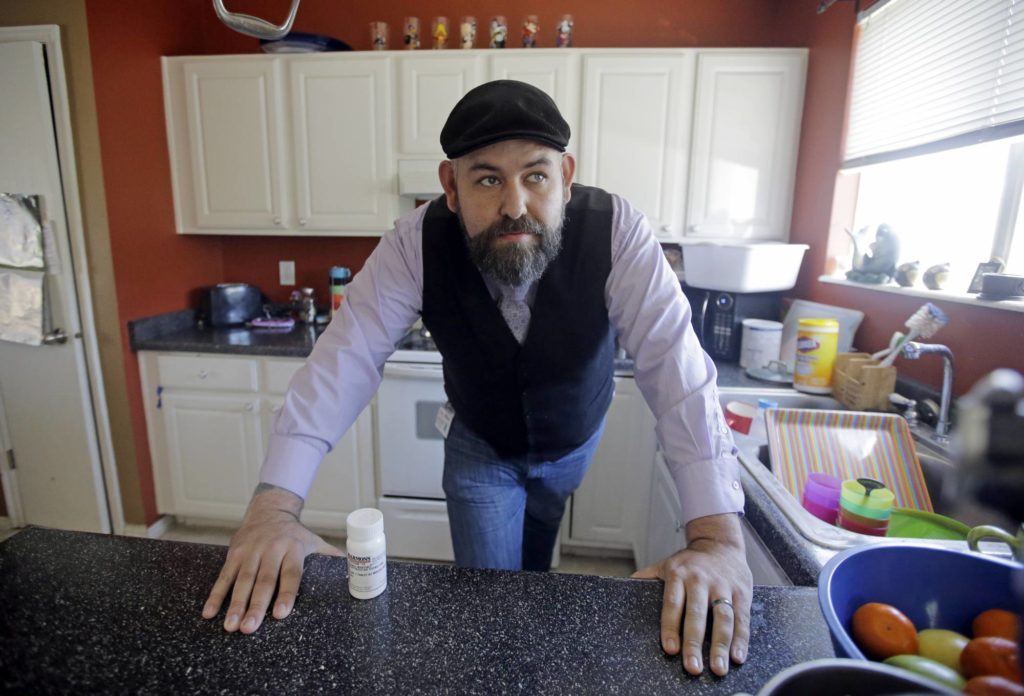Anxiety over GOP health plan for those with severe illnesses

Unease and uncertainty are settling over Americans with serious illnesses as Republicans move closer to dismantling Democratic former President Barack Obama‘s health care system. A New Orleans attorney with multiple sclerosis fears he’ll be forced to close his practice if he loses coverage, while a Philadelphia woman with asthma is looking at stockpiling inhalers. The Republican health care bill pushed through the House on Thursday leaves those with pre-existing conditions fearful of higher premiums and losing coverage altogether if the Affordable Care Act is replaced. The bill sets aside billions of dollars more to help people afford coverage, but experts say that money is unlikely to guarantee an affordable alternative for people now covered under a popular provision of the existing law that prevents insurers from rejecting them or charging higher rates based on their health. What happens to those with pre-existing conditions under the Republican plan remains unknown. Several people unsettled by the prospects expressed these concerns. ___ FORMER UTAH CHEF Jake Martinez said he’s worried about getting health insurance in the future because he has epilepsy, considered a pre-existing condition by insurers. For the last several years, he, his wife and their three children have settled into a comfortable place using health insurance under the Affordable Care Act. But now the Murray, Utah, residents are worried about what may happen with this new health care bill. “Today, it really kind of sunk in that not only are we not going to potentially have health care coverage but that it was done as a political win rather than a well-thought-out plan,” said Martinez, a 32-year-old former chef who’s studying social work. “That’s what stings about it.” ___ KENTUCKY ATTORNEY Shortly after being diagnosed with type I diabetes, Amanda Perkins learned about the perils of pre-existing conditions when she starting trying to buy health insurance. Now she worries that protections under the Affordable Care Act that made sure certain essential health benefits, like insulin prescriptions, could be eliminated. The new Republican plan would let some states allow insurers to charge higher premiums for people with pre-existing conditions, but only if those people had a lapse in insurance coverage. Supporters say those states would need to have programs in place to help people pay for expensive medical treatments, including high-risk pools. But Perkins said Kentucky’s previous high-risk pool had a 12-month waiting period and was too expensive for her. “I bought a house just a couple of months ago. Will it come down to me paying my mortgage payment or paying my health insurance so I don’t have a lapse in coverage?” said Perkins, an attorney for a small firm in Lexington, Kentucky. ___ KANSAS GRAPHIC DESIGNER Janella Williams has a rare neurological disorder that forces her to receive expensive IV drugs every seven weeks. Without it, she would not be able to walk. Williams, who owns her own graphic design company in Lawrence, Kansas, pays $480 under an Obamacare plan. It keeps her out-of-pocket maximum at $3,500 a year and provides her coverage despite her pre-existing condition. “I’m terrified of becoming disabled. If I’m being completely honest, I’ve thought of ending my life if it comes to that,” she said. High-risk pools run by the state are not the answer, she says. The Republican plan would also bring back lifetime caps on coverage, which Williams says she would meet after only her first IV treatment. She and her husband both work full time, but wouldn’t be able to afford the roughly $600,000 a year her treatments cost once the cap is met. “I have really lost my faith in humanity,” she said. “It’s terrible how little we care for the sick.” ___ NORTH CAROLINA FINANCIAL ADVISER John Thompson credits his survival in large part because he bought a family insurance policy through the Affordable Care Act marketplace. Thompson, of Greensboro, North Carolina, was laid off in 2013, lost his employer-backed insurance and diagnosed with cancer during the year he was unemployed. If the House proposal allowing insurers to make coverage for pre-existing conditions unaffordable takes hold, he fears his cancer history will make him uninsurable if he would lose his current job as a retirement financial adviser. “Like many of us here, whether you have asthma or a heart condition or diabetes or like me, cancer, any type of pre-existing condition, you go back to the way it was before, you give insurance companies carte blanche to do their underwriting and to exclude you,” Thompson said. ___ FLORIDA MOM Shelby Jehlen, of New Port Richey, Florida, was diagnosed six years ago with leukemia and says she wouldn’t be able to afford insurance if she lost her roughly $400 a month subsidy. Jehlen saves about $1,000 every three months to see her cancer doctor under her Obamacare plan, but still pays about $1,500 for the check-ups. She was forced to quit work because of all the X-rays and other chemicals she was exposed to daily as a veterinary assistant and now cuts corners, sacrificing phones and school activities for her two teen daughters, to afford the monthly premiums. The stress has caused her to struggle with depression and anxiety. “Absolutely, I’m scared. I’m worried I’m going to have to figure out what I’m going to do with all my side effects with my leukemia if they take this away from me,” she said. ___ PHILADELPHIA BUSINESSWOMAN Adrienne Standley has been preparing for the possibility of losing her insurance since President Donald Trump took office. Three days after the inauguration, she set up an appointment for a birth control implant so she would be covered for four years, no matter what happens. The 29-year-old operations director at a start-up apparel business in Philadelphia also has asthma and attention deficit disorder. “I’m looking at stockpiling, making sure I have an inhaler,” she said. “I’m pretty scared to lose coverage.” ___ NEW ORLEANS ATTORNEY John S. Williams says he’ll be forced to close his practice and find a job with a group insurance
New Orleans takes down white supremacist monument

A monument to a deadly white-supremacist uprising in 1874 was removed under cover of darkness by workers in masks and bulletproof vests Monday as New Orleans joined the movement to take down symbols of the Confederacy and the Jim Crow South. The Liberty Place monument, a 35-foot granite obelisk that pays tribute to whites who tried to topple a biracial Reconstruction government installed in New Orleans after the Civil War, was taken away on a truck in pieces before daybreak after a few hours of work. In the coming days, the city will also remove three statues of Confederate Gens. Robert E. Lee and P.G.T. Beauregard and Confederate President Jefferson Davis, now that legal challenges have been overcome. The removal of the obelisk was carried out early in the morning because of death threats and fears of disruption from supporters of the monuments. The workers wore military-style helmets and had scarves over their faces. Police were on hand, with officers watching from atop a hotel parking garage. “The statue was put up to honor the killing of police officers by white supremacists,” Landrieu said. “Of the four that we will move, this statue is perhaps the most blatant affront to the values that make America and New Orleans strong today.” Citing safety concerns, the mayor would not disclose exactly when the other monuments would be taken down, except to say that it will be done at night to avoid trouble. He said the monuments will be put in storage until an appropriate place to display them is determined. Nationally, the debate over Confederate symbols has flared since nine black parishioners were shot to death by an avowed racist at a church in Charleston, South Carolina, in 2015. South Carolina removed the Confederate flag from its statehouse grounds in the weeks after, and several Southern cities have since considered removing monuments. The University of Mississippi took down its state flag because it includes the Confederate emblem. New Orleans is a mostly black city of nearly 390,000. The majority-black City Council voted 6-1 in 2015 to take the monuments down, but legal battles held up action. Landrieu, a white Democrat, proposed the monuments’ removal and rode to victory twice with overwhelming support from the city’s black residents. Opponents of the memorials say they are offensive artifacts honoring the region’s racist past. Others say the monuments are part of history and should be preserved. Robert Bonner, a 63-year-old Civil War re-enactor, was there to protest the monument’s removal. “I think it’s a terrible thing,” he said. “When you start removing the history of the city, you start losing money. You start losing where you came from and where you’ve been.” The Monumental Task Committee, which sued to preserve the memorials, condemned the middle-of-the-night removal as “atrocious government.” The Liberty Place monument was erected in 1891 to commemorate the failed uprising by the Crescent City White League. Sixteen White Leaguers, 13 members of the white and black Metropolitan police force and six bystanders were among those killed in the bloody battle down Canal Street. President Ulysses Grant sent federal troops to take the city back three days later. However, the White League grew in power in New Orleans after the battle, with its members and allies taking over the city and state government after Reconstruction. An inscription added in 1932 said the Yankees withdrew federal troops and “recognized white supremacy in the South” after the uprising. In 1993, those words were covered by a granite slab with a new inscription, saying the obelisk honors “Americans on both sides” who died and that the conflict “should teach us lessons for the future.” New Orleans removed the memorial from busy Canal Street during a paving project in 1989 and didn’t put it back up until the city was sued. Even then, it was consigned to an obscure spot on a side street. Landrieu said the memorials don’t represent his city as it approaches its 300th anniversary next year. Removing the monuments is “not about blame,” the mayor said. Rather, he said, it’s about “showing the whole world that we as a city and as people are able to acknowledge, understand, reconcile and — most importantly — choose a better future, making straight what has been crooked and right what has been wrong.” Republished with permission of The Associated Press.
Court opens door to BP settlement appeals

A federal appeals court has opened the door for BP to appeal some claims related to a settlement reached after the 2010 Gulf of Mexico oil spill. The 5th U.S. Circuit Court of Appeals in New Orleans ordered a lower court judge to change a procedure that effectively blocked appeals. And the appeals court told the judge to reconsider a rule barring BP from appeals regarding the calculation of a business’ losses. However, the court upheld the lower court’s ruling that barred appeals dealing with payments to nonprofit groups. And, it said the court could continue to prevent appeals arising from BP’s contention that something other than the oil spill caused some businesses’ losses — an issue the oil giant has fought unsuccessfully for years. The opinion released late Friday is the latest dealing with a 2012 settlement of oil spill economic loss litigation. The settlement agreement was hailed by all involved when it was signed but soon became the subject of contention over the way it was interpreted by the district court in New Orleans and the court-appointed claims administrator. BP eventually won a change in the way losses are calculated after arguing that administrator Patrick Juneau wasn’t correctly matching businesses’ revenue and expenses. The appeals court, noting that the methodology has changed and has been the subject of numerous developments that “muddy the waters,” told the district court, where U.S. District Judge Carl Barbier, is overseeing spill cases, to take another look at the issue, and to provide reasons if the bar is continued. In 2012, BP estimated it would pay about $7.8 billion to resolve claims under the settlement. A fourth-quarter earnings statement put the estimate at closer to $10 billion, while noting that there were various factors that could change that number. BP and lawyers pursuing claims both found something to like in Friday’s ruling. “We are pleased that the 5th Circuit upheld our right to appeal individual claims determinations,” company spokesman Geoff Morrell said in an emailed statement. The company did not estimate how the decision might affect the cost of claims. “With regard to ‘alternative causation,’ we’re pleased the 5th Circuit saw through BP’s latest attempt to re-fight an issue that it has lost on every level,” plaintiffs’ attorneys Steve Herman and Jim Roy said in an email. “We’re further pleased the court shut the door on BP’s effort to deny the claims of nonprofit organizations.” Republished with permission of The Associated Press.


